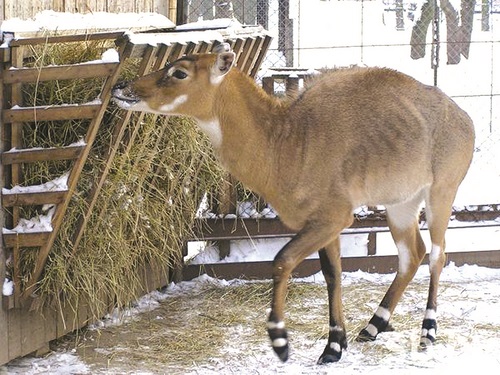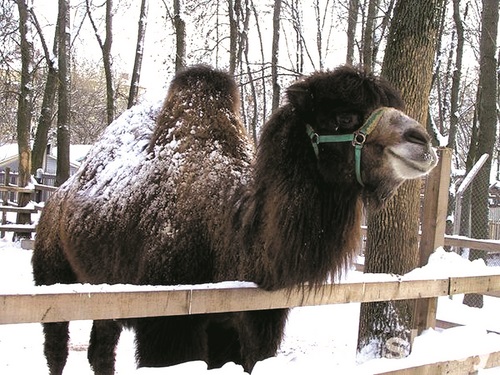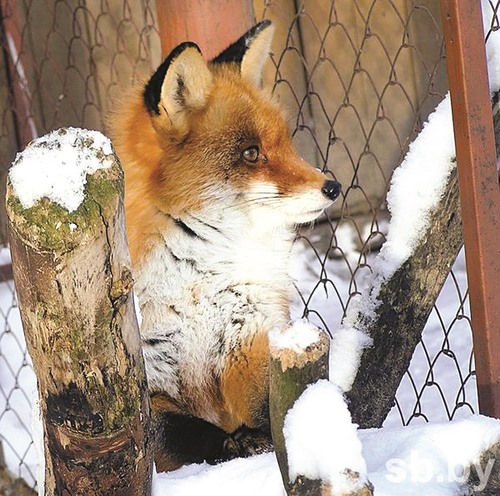Tunnels and pathways between the open air cages create the illusion of nature in the wild. In spite of the fact that it’s still sometimes cold at nights, and a snowstorm has been recently raging here, life in Vitebsk zoo goes according to plan.

A bag with apples, bananas and other essentials is for the brown greater galago. Lemurs and similar animals lead a mostly twilight life and don’t appear for the public before 5pm. They will immediately ask for their dinner, which consists of boiled chicken breast, quail’s eggs, baby food and … live cockroaches. Cockroaches do not slow down in the winter, they breed with identical speed and are used as a nutritious food source. Cormorants and herons are cheerfully walking around in open air enclosures; these birds don’t even know about southern skies. They appear to appreciate however, the comfort of the stove which is kept constantly warm for them. The director of the Vitebsk zoo, Irina Orlova, tells us: “In total, we have four furnaces. Before the start of the winter season we replaced the stoves with new ones, especially to protect the animals against the cold.” She offers me the chance to look at these creatures from warmer climates.
The warmest perhaps, is the monkey house. It is the most popular place for visitors and, shortly before the New Year, we had a significant event here. In the family of long-tailed macaques, Lucy and Vasya had a third little son. He already periodically comes unhooked from his mother and takes some exercise like a little acrobat. While I am becoming acquainted with the life of a macaque, the ten-month old Masik has become interested in my camera, or rather in the lens cover. In half a minute he has deftly crossed the couple of metres dividing us, and his tenacious hands grabbed the ‘toy’. I then have to persuade the unwilling Masik to give it back, which he eventually does.

Life is more active for outdoor dwellers. Irina describes how the female bear Ruslana went into hibernation before frosts. Now her den is regularly inspected and new hay and straw put down if required. The antelope Katya does not want to sleep. Despite her southern origin, she can easily stand the cold. She has her own winter ‘apartment’, but Katya prefers walking outside during the greater part of the day. Even when the storms were at their worst, her curiosity kept her outside. Possibly because she did not want to lose face before her neighbour Masha, a red deer, who enjoys the bad weather.
Lions are also not afraid of the cold. Kuat and Markusha lie, relaxed, looking blissfully unaware as they catch snowflakes on their noses. “If the temperature is not below 10 degrees, the lions feel quite comfortable. When the frost is harder they move into their house. But they also prefer to spend the greater part of the day in the open air. It is more interesting for them.”

Vitebsk zoo dwellers
Irina Orlova describes the way of life of the outdoor inhabitants. “During the wintertime all our animals receive increased portions, we enrich their food with fruit and vegetables. Before giving them carrots, cabbage, beet and potato, we warm them in hot water. This diet enriched and adapted for cold weather is an essential part of looking after animals in the winter. Lions, for example, receive a bigger portion of boneless beef. And what about gnawing on a bone? For this purpose, they have special toys. Jaguar Yarik also often refuses his warm quarters. He, as well as other animals living in the open air, receive warm water three times a day.”
Just at that moment, the Camels Asya and Timon are getting warm water, and steam rises from their drinking bowl. But these huge animals with snow-covered humps are not going to drink at the moment because they are looking at the visitors. “Camels don’t hide during a blizzard. They lie slowly turning into snowdrifts. And then they get up, shake themselves and go for their hay,” workers at the zoo joke. “They give the impression that they were born in the Far North.” The Auroch, Borka, looks impressive against the background of snow and frost, practically in the centre of Vitebsk. Majestic and proud yet aloof, we are almost afraid to get close to him. The lama, Milka, is not afraid of the snow either. She gracefully approaches us, and stretches out her attractive nose in expectation of food.
The wolves darting about in the open-air cage nearby, would like to get more closely acquainted with the lama. These smooth predators are standing still at the den’s exit from the den as if in readiness to jump. My guide reacts and shouts at this display of aggression and the wolf gives her a guilty look, then their ears lose their sharpness. A small enclosure is enough for the foxes whose snow is trampled by small paws. These nimble animals are constantly whirling around, remodelling the forest landscape. They wait patiently while their food is delivered. And even the beautiful lynx, Vaska, whose open-air enclosure is in a quiet place, is ready to exchange the habits of a predator for the warmth and care of humans.
By Yelena Begunova











